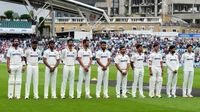The World Test Championship (WTC) 2025-27 cycle has already delivered its share of drama, upsets, and high-stakes calculations, and we’re not even halfway through. For Indian cricket fans, the recent 30-run defeat to South Africa at Eden Gardens, Kolkata, has added an extra layer of urgency—and a dash of anxiety—to the campaign. With Australia cruising at the top, South Africa surging, and Sri Lanka quietly keeping pace, the battle for a spot in the WTC Final at Lord’s in June 2027 is heating up like never before.
Australia currently sit pretty atop the WTC points table, boasting a flawless record: three matches, three wins, and a pristine 100% points percentage. That’s the kind of start every team dreams of, but only the Aussies have managed it so far. Hot on their heels, South Africa have leapt from fifth to second in the standings after their gritty win in Kolkata, now holding two wins from three matches and a 66.67% points percentage. Sri Lanka, with a win and a draw from two matches, are tied with the Proteas on percentage points but sit third due to fewer matches played.
The real shake-up, though, has come further down the order. India, perennial contenders and two-time WTC finalists, have slipped from third to fourth after the Eden Gardens setback. Their current record reads: eight matches, four wins, three losses, one draw, and a points percentage of 54.17. Not disastrous by any means, but given the cutthroat format of the WTC, every slip counts. As the numbers stand, India now face a mathematical puzzle with little room for error if they want to make it to Lord’s next summer.
Let’s dive into how things unraveled at Eden. The pitch at Kolkata was a talking point even before a ball was bowled, and by the end, it was the center of controversy. South Africa were bundled out for just 159 in their first innings, thanks to a Jasprit Bumrah masterclass—he bagged a five-wicket haul, reminding everyone why he’s one of the world’s most feared bowlers. India looked to capitalize, with KL Rahul top-scoring at 39, but the innings was punctuated by setbacks: Shubman Gill had to retire hurt due to a neck spasm. Still, India eked out a slender 30-run lead.
South Africa’s second innings saw captain Temba Bavuma steady the ship, remaining unbeaten on 55 as Ravindra Jadeja spun his web to snare four wickets. The Proteas posted 153, setting India a modest target of 124. But what followed was a collapse that left fans shell-shocked. India were bowled out for just 93, with Washington Sundar (31) and Axar Patel (26) offering the only resistance. Simon Harmer, who had already snared four wickets in the first innings, repeated the feat to finish with eight wickets in the match. As for India, captain Shubman Gill didn’t bat in the second innings, still sidelined by his earlier injury.
This defeat marked India’s first home Test loss to South Africa in 15 years—the last time being in Nagpur back in 2010. It also exposed vulnerabilities in the Indian lineup that can’t be masked by sheer talent alone. The Eden pitch, now under scrutiny, has sparked debates across cricketing circles, but the bigger concern for India is the points table. With only ten matches left in their WTC campaign, the margin for error is razor-thin.
So, what’s the road ahead for India? The equation is as straightforward as it is daunting. India must win at least seven of their remaining ten Tests to stay in serious contention for a place in the WTC Final. That would bring their points percentage to roughly 64-65%, a figure that’s historically been enough to secure a top-two finish. Eight wins would almost guarantee qualification at around 68.5%. The remaining fixtures aren’t exactly a cakewalk: one more Test against South Africa at home (in Guwahati starting November 22), two away in Sri Lanka, two away in New Zealand, and a grueling five-Test home series against Australia.
Mathematically, here’s how the scenarios play out: if India draws the series 1-1 with South Africa, they’ll climb back to third with a 59.26% points percentage. Lose 0-1, and they remain fourth at 51.85%. A 0-2 defeat would see them drop to fifth at 48.15%. The stakes couldn’t be higher for the Guwahati Test, which is shaping up to be a must-win affair for the home side.
Despite their current predicament, India’s core remains formidable. The top four run-scorers of the WTC 2025-27 cycle so far are all Indian batters, and on the bowling front, Mohammed Siraj leads with 37 wickets, followed by Jasprit Bumrah with 27. The talent is there—what’s needed is relentless consistency and a bit of tactical sharpness, especially under pressure.
For South Africa, the win in Kolkata is a massive boost. Having drawn their previous WTC series 1-1 against Pakistan, the Proteas now look ahead to a two-Test series in Sri Lanka in February 2027, and home series against Australia, Bangladesh, and England. Their current points percentage keeps them in the hunt for another shot at the title—the very title they won in 2025 by defeating Australia in the WTC Final. That win made South Africa the reigning champions, while India, despite reaching the final twice (2021 and 2023), are still searching for their maiden crown.
The WTC format, with its points percentage system, ensures that every match counts, regardless of how many games each team plays. Teams are awarded 12 points for a win, 6 for a tie, and 4 for a draw, with deductions for slow over rates. The top two teams at the end of the cycle will face off in the Final, scheduled—pending official confirmation—for June 2027 at Lord’s, London. The Ashes series later this year could also play a pivotal role in shaping the final table, especially with England still in the mix.
As things stand, Australia’s dominance is undisputed, but the race for the second spot is wide open. India’s next Test against South Africa in Guwahati isn’t just another match—it’s a potential turning point in their WTC campaign. A win could reignite their hopes, while another loss might leave them with too much ground to make up. Fans and pundits alike will be watching closely as the drama unfolds, with every run, wicket, and session carrying implications for the road to Lord’s.
With the stakes sky-high and the competition fierce, the World Test Championship 2025-27 is delivering cricket at its most compelling. As the dust settles on Eden Gardens and the focus shifts to Guwahati, one thing is clear: the fight for the Final is only just beginning, and every team in contention knows there’s no room for complacency.





